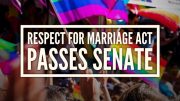 By: Lisa Keen/Keen News Service—
By: Lisa Keen/Keen News Service—
Even before 2013 began, everyone knew what the big news story for 2013 would be. The U.S. Supreme Court had, in December 2012, agreed to hear to two high-profile marriage cases: One testing the right of the federal government to refuse equal benefits to same-sex married couples, and the other testing the right of a state to ban same-sex couples from marrying.
What no one knew for sure was how the court would rule. And speculation in December 2012 was all over the map. Even long-time court observers who routinely cautioned against predicting how the court might rule couldn’t resist predicting how the court might rule.
There was unprecedented media attention and public interest in the oral arguments, held on successive days in March. And then, on June 26, the court ruled. The results were not everything the LGBT community wished for but they were far more than many in the community expected to see in their lifetime. [pullquote]In 2003, when the U.S. Supreme Court struck down laws prohibiting private intimate contact between same-sex partners (in Lawrence v. Texas), then President George W. Bush had nothing to say… Following the two landmark rulings in marriage equality cases before the Supreme Court in 2013, President Obama issued an immediate statement in support of the rulings and “directed the Attorney General to work with other members of my Cabinet to review all relevant federal statutes to ensure this decision, including its implications for Federal benefits and obligations, is implemented swiftly and smoothly.”[/pullquote]
Those two rulings alone made 2013 perhaps the “Best Year Ever for the LGBT Movement” toward equal rights in this country. Their impact was deep and wide, politically, symbolically, and literally. But there were other breath-taking developments –including the unexpected—that secured 2013 as the most successful year in the movement’s seven decades of organized struggle. Here are our picks:
No. 10: The U.S. Senate gets its first openly gay member.
U.S. Rep. Tammy Baldwin, a seven-term representative from Madison, Wisconsin, who embodied the polite, witty, but determined temperament of a Midwesterner, added another “first” to her already long list of accomplishments. Before January, she was already the first open lesbian elected to the Wisconsin Assembly, the first openly gay person elected to the U.S. Congress, the first open lesbian in the House, and the first woman elected to Congress from Wisconsin. After being sworn in to the 113th session, she became Wisconsin’s first woman senator and the U.S. Senate’s first openly gay member. Her colleagues praised her diplomacy in the successful effort to get ENDA approved by the Senate was praised and she became the first rookie senator to win the U.S. Senate’s “Golden Gavel” award for having presided over the chamber’s activities for more than 100 hours.
No. 9: Congress gets its largest ever LGBT Caucus.
Not only was U.S. Senator Tammy Baldwin in the Senate, as of the start of the 113th Congress, there were six openly LGBT members in the U.S. House, and by year’s end, there was seven. Prior to 2013, the LGBT Caucus numbered four and, with the retirement of Rep. Barney Frank at the end of 2012, it looked like it might dwindle to three: Baldwin and Reps. Jared Polis (D-Colo.) and David Cicilline (D-RI). But fresh off newcomer victories in November 2012, the four new openly LGBT reps were sworn in: Kyrsten Sinema (D-Ariz.), Mark Takano (D-Calif.), Sean Maloney (D-NY), and Mark Pocan (D-Wisc.). And, in November, Rep. Mike Michaud (D-Maine) came out in an op-ed to ward off a whisper campaign by his opponents in the 2014 Maine gubernatorial race. The Caucus size doubled to eight over the previous high.
No. 8: The U.S. Senate passes ENDA for the first time.
The Senate had voted on the Employment Non-Discrimination Act once before in the bill’s nearly four decades as the LGBT movement’s flagship piece of legislation. In that first tally, taken in 1996, it lost by one vote. This year, it passed 64 to 32, and only one senator spoke against it (long-time gay civil rights opponent Dan Coats, a Republican from Indiana). A Republican-dominated House gives the bill virtually no chance to even reach the floor there, but passage in the Senate signaled that a new and friendlier political landscape had been established in LGBT civil rights.
No. 7: President Obama’s second inaugural promotes equality.
He had already “evolved” to the point where he stated publicly, in July 2012, that he supports the right of same-sex couples to marry. And while LGBT leaders always hope a major presidential address will at least mention LGBT people when identifying the nation’s strength in diversity, no one had expected President Obama to go beyond that in his second inaugural. But he went much further: “We, the people, declare today that the most evident of truths – that all of us are created equal – is the star that guides us still; just as it guided our forebears through Seneca Falls, and Selma, and Stonewall. … Our journey is not complete until our gay brothers and sisters are treated like anyone else under the law – for if we are truly created equal, then surely the love we commit to one another must be equal as well.”
No. 6: NJ drops appeal of court ruling that struck state marriage ban.
Following the U.S. Supreme Court’s ruling in U.S. v. Windsor that the key provision of the federal Defense of Marriage Act (DOMA) was unconstitutional, Lambda Legal asked a state court judge in New Jersey to rule in a pending case, Garden State v. Dow, that the state ban on marriage was harming same-sex couples by preventing them from having access to federal benefits associated with marriage. The judge did just that in late September and ordered the state to comply starting October 21. When Republican Governor Chris Christie sought an emergency stay of that order, the state supreme court rejected the request and New Jersey became the 14th state with marriage equality. The unanimous and forceful reasoning in the court’s refusal prompted Christie to drop his appeal of the ruling, providing another powerful political sign that acceptance of the right of gay people to equal protection of the law was becoming the new expectation.
No. 5: Five state legislatures passed marriage equality laws.
Rhode Island (April), Delaware (May), Minnesota (May), Illinois (November), and Hawaii (November). In the ten years prior, only four state legislatures and the District of Columbia had approved marriage equality legislation and seen it signed into law. The debate in each legislature was marked by emotional and dramatic testimony, much of it from former opponents of same-sex marriage who had evolved on the issue. A Rhode Island senator spoke of being a life-long devout Catholic who said “I struggled with this for days and weeks and have been unable to sleep.” In the end, she said, she could not vote against friends and constituents in same-sex relationships. In Hawaii, where same-sex couples mounted one of the first legal challenges in the country in the 1990s, opponents organized an unprecedented flood of citizens to public hearings –literally thousands of people expressed anger and threats of political retribution. But the resolve of legislators willing to stand “on the right side of history” held firm. By year’s end, 16 states and the District of Columbia had approved marriage equality.
No. 4: Russia passes laws outlawing “promotion” of homosexuality.
In June and July, Russian President Vladimir Putin signed laws to prohibit the “propaganda of nontraditional sexual relations around minors,” any public displays of affection by same-sex couples, public events related to LGBT people, and any adoptions of Russian children by couples from countries where marriage equality is law. One Russian law even allows authorities to arrest and detain anyone suspected of being gay or pro-gay. LGBT activist groups immediately pushed back, some calling for a boycott of the Winter Olympics scheduled for Sochi, Russia, in February 2014. The boycott idea quickly faded, but many U.S. officials found ways to register their unhappiness over the draconian legislation. President Obama said that countries participating in the Olympics “wouldn’t tolerate gays and lesbians being treated differently” during the 2014 Olympics. He also canceled his one-on-one meeting with Putin at a September G-20 summit, citing “human rights and civil society” issues. Pressure on corporate sponsors of the events elicited statements in support of LGBT people and one international human rights organization called on the Obama administration to include LGBT leaders in its official delegations to the opening and closing ceremonies.
No. 3: President Obama responds to Supreme Court rulings.
In 2003, when the U.S. Supreme Court struck down laws prohibiting private intimate contact between same-sex partners (in Lawrence v. Texas), then President George W. Bush had nothing to say and his administration took no action to determine to what extent the Lawrence ruling might apply to various federal programs. Following the two landmark rulings in marriage equality cases before the Supreme Court in 2013, President Obama issued an immediate statement in support of the rulings and “directed the Attorney General to work with other members of my Cabinet to review all relevant federal statutes to ensure this decision, including its implications for Federal benefits and obligations, is implemented swiftly and smoothly.” Two major federal departments announced that their interpretations of the U.S. v. Windsor opinion would bring benefits to married same-sex couples regardless of whether a couple’s state of residence recognizes the marriage. And the Internal Revenue Service announced that legally married same-sex couples “will be treated as married for all federal tax purposes,” including for income tax filing, gift and estate taxes, individual retirement accounts, and in other tax regulations where marriage is a factor.
No. 2: Supreme Court leaves intact ruling that struck down Prop 8.
With Chief Justice John Roberts writing for 5 to 4 majority, the U.S. Supreme Court ruled that the defenders of Proposition 8, the California voter-approved ban on same-sex marriage, did not have proper federal standing to appeal a district court judge’s ruling that the measure was unconstitutional. It was not, in other words, a ruling on the merits of the underlying legal issue in Hollingsworth v. Perry. But by refusing to accept the Yes on 8 appeal, the court left the district court judge’s ruling intact, and same-sex couples began obtaining marriage licenses once again in California. Reaction was understandably euphoric from LGBT legal activists and the thousands of supporters of same-sex marriage gathered outside the Supreme Court building in Washington and town hall in San Francisco where the case began in 2009. The Perry decision, and another that struck down the key provision of DOMA, were issued on the tenth anniversary of the 2003 Lawrence v. Texas decision, which struck down state laws that prohibited intimate relations between partners of the same sex. And while the Perry decision fell short of declaring all state bans on same-sex marriage to be unconstitutional, it set off a tidal wave of new litigation seeking to do just that. At year’s end, Freedom to Marry’s Executive Director Evan Wolfson estimated there are 44 lawsuits in 19 or 20 states “moving forward.”
No. 1: Supreme Court strikes down key provision of DOMA.
With Justice Anthony Kennedy writing for a 5 to 4 majority, the U.S. Supreme Court declared on June 26 that the key provision of the Defense of Marriage Act (DOMA) was unconstitutional. That provision (known as Section 3) had barred any federal entity from recognizing for the purpose of any benefit the valid marriage license of a same-sex couple. The majority opinion in U.S. v. Windsor said DOMA Section 3 violated the constitutional guarantees of equal protection and due process. The DOMA decision, said GLAD Civil Rights Director Mary Bonauto who organized the first lawsuit against Section 3, “not only strikes DOMA but makes clear what we’ve been saying all along –that DOMA is discriminatory and that it is an effort by the federal government to deprive same-sex couples of their rights and to demean them.” The decision began working like the first domino to fall in a long line of laws, state and federal, that deprived same-sex couples if equal benefits. State legislators cited it during debates over marriage equality bills; state and federal courts cited it to strike down other DOMA-like laws and regulations. “It seems fair to conclude that, until recent years, many citizens had not even considered the possibility that two persons of the same sex might aspire to occupy the same status and dignity as that of a man and woman in lawful marriage,” wrote Justice Kennedy. “For marriage between a man and a woman no doubt had been thought of by most people as essential to the very definition of that term and to its role and function throughout the history of civilization. That belief, for many who long have held it, became even more urgent, more cherished when challenged. For others, however, came the beginnings of a new perspective, a new insight. Accordingly some States concluded that same-sex marriage ought to be given recognition and validity in the law for those same-sex couples who wish to define themselves by their commitment to each other. The limitation of lawful marriage to heterosexual couples, which for centuries had been deemed both necessary and fundamental, came to be seen in New York and certain other States as an unjust exclusion.”
© copyright 2013 by Keen News Service. All rights reserved.







